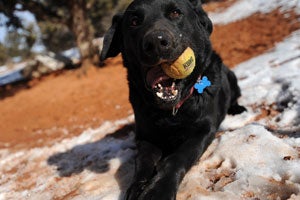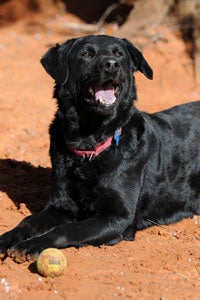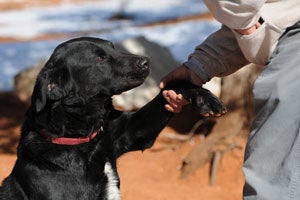Teaching a Labrador retriever to trade

Giving up something good for something better certainly has its rewards, yet it can be a tricky concept for an animal to learn. For Archie the dog, he had a tough time figuring out that in order to play fetch, arguably his favorite thing in the world, he had to first be willing to drop the tennis ball.

Ready to play ball
Archie is a black Labrador retriever mix with a sky-high play drive. Until recently, if you tried picking up one of his toys, you’d be putting your fingers at risk. Not that Archie was aggressive. It’s more that he would become so ecstatic at the notion of a game of fetch, he simply wouldn’t notice your fingers.
Even when his caregivers used a long-handled ball chucker, Archie was still a handful. This is a dog who enthusiastically smiles — literally — at the very sight of a toy.
Dog clicker training
Josh Bennett, one of Archie’s caregivers, wanted to see if such toy obsession could be put to good use. "Archie has a really high retriever drive," he says. "I thought I could use that to my advantage."

Archie is always smiling.
The first step was to remove most of Archie’s toys from the play area, especially tennis balls. "The tennis balls, I found out, were the high-value toy for him," Josh explains. When Josh showed up later with two tennis balls in hand, and treats to boot, you can bet he had Archie’s full attention.
Combining clicker training with treats and verbal cues, Josh taught Archie to sit and wait until he tossed the first ball. Once Archie dashed off, deliriously happy, and brought back the first tennis ball, Josh had the second one ready to rock. At that point, Josh waited to throw the second ball until Archie dropped the first.
In other words, a trade. But a trade Archie could accept. He finally found something worth dropping his favorite toy over. Archie would probably hike 10 miles uphill both ways for a five-minute round of fetch.
Josh, as well as other caregivers, continued working with Archie using these techniques. In time, Archie was playing fetch to his heart’s content. "He really wanted to retrieve the ball and bring it back. He just had to learn the right way to do it," Josh points out. These days, Archie drops the ball on his own, backs up a few steps, sits down, then stares at the ball with rapt attention while wagging his tail. He’s even progressed to using only one ball.

Archie has really come a long way.
Now that Archie has learned to play safely, treats are no longer necessary. "It’s just the game now," Josh says.
Helping a dog to apply training lessons elsewhere
Similar training techniques worked in helping Archie let go of other bad habits. One of these was Archie’s tendency to always tug on the leash in the direction of the dog park. Using treats and positive reinforcement, Archie’s caregivers managed to convince him it’s actually OK to go for walks in which the destination is not the dog park.
Archie also learned that if he was willing to give up chewing on blankets during car rides, he could chew on Kong toys instead. Major upgrade.
Bottom line, letting go some of our favorite things isn’t always easy. But if we receive even better things in return, so far as Archie is concerned, that’s a big reason to smile.
Adopt from Best Friends
In the market for a dog companion? Consider adopting a delightful pooch from the Sanctuary.